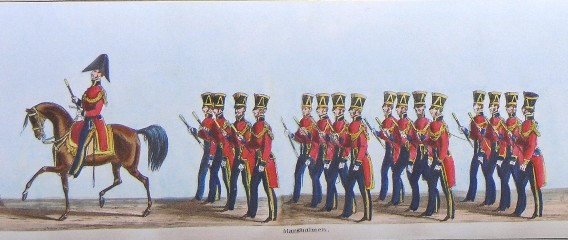Knight Marshal on:
[Wikipedia]
[Google]
[Amazon]
 The Knight Marshal is a former office in the
The Knight Marshal is a former office in the
 A token number of Marshalmen continued to be appointed even after the demise of the Marshalsea Court; they became honorary appointments within the Royal Household and were in attendance on the Sovereign on ceremonial occasions. Six King's Marshalmen took part in the 1937 Coronation procession of King George VI; since when appointments to this office have ceased. The Marshalmen wore a distinctive uniform, consisting of a scarlet coat, blue trousers and a
A token number of Marshalmen continued to be appointed even after the demise of the Marshalsea Court; they became honorary appointments within the Royal Household and were in attendance on the Sovereign on ceremonial occasions. Six King's Marshalmen took part in the 1937 Coronation procession of King George VI; since when appointments to this office have ceased. The Marshalmen wore a distinctive uniform, consisting of a scarlet coat, blue trousers and a
Photograph of Marshalmen on duty at the State Opening of Parliament in 1909 (National Portrait Gallery)
{{British Monarchy Household Positions within the British Royal Household
 The Knight Marshal is a former office in the
The Knight Marshal is a former office in the British Royal Household
The Royal Households of the United Kingdom are the collective departments that support members of the British royal family. Many members of the royal family who undertake public duties have separate households. They vary considerably in size, ...
established by King Henry III in 1236. The position later became a Deputy to the Earl Marshal
Earl marshal (alternatively marschal or marischal) is a hereditary royal officeholder and chivalric title under the Monarchy of the United Kingdom, sovereign of the United Kingdom used in England (then, following the Act of Union 1800, in the U ...
from the reign of King Henry VIII until the office was abolished in 1846.
The Knight Marshal and his men were responsible for maintaining order within the King's Court ( Court of Marshalsea or Palace Court
The Marshalsea Court (or Court of the Marshalsea, also known as the Court of the Verge or the Court of the Marshal and Steward) was a court associated with the Royal Household in England. Associated with, but distinct from, the Marshalsea Court ...
) which was abolished in 1849.
According to ''The Present State of the British Court'', published in 1720,
The Knight Marshal was appointed by the Crown for life by letters patent under the great seal frequently in the form of grants in reversion. Board wages were fixed at £21 5s 10d in 1662. In 1685, a salary of £26 was provided. This was raised to £500 in 1790 but reduced to £271 in 1816.
The separate office of Knight Marischal exists in the Royal Household of Scotland, but has not been filled since 1863.
List of Knights Marshal
*temp Richard III : William Brandon *temp Edward IV : Sir Ralph Assheton *temp Henry VII : Sir John Digby *temp Henry VIII : Sir William Pickering *1542 26 August – 1556 : Sir Ralph Hopton (died 1571) *1555 : Sir Anthony Kingston (died 1556) *1556 May – 1558 : Sir Thomas Holcroft *1558 Mar – 1558 : Sir Thomas Hervey *1558 21 Dec – 1571 : Sir Ralph Hopton and Robert Hopton (jointly) *1571 - 1577: Robert Hopton (alone) *1578: Sir George Carey *1597 May : Sir Thomas Gerard (created Baron Gerard, 1603) *1604 – 1618 : Sir Thomas Vavasour *1618 – 1626 : Sir Edward Zouche *1626 – 1642 : Sir Edmund Verney *c.1642 : Sir Edward Sydenham *?1651 : Sir Robert Throckmorton *1649 – 1660 : ''Interregnum'' *1660 11 July : Sir William Throckmorton *1667 22 April : Sir Edmund Wyndham *1681 3 March – ?1689 : Sir Edward Villiers *1689 4 July : Sir Edward Villiers (died 1711) *1700 11 July – 1757 : Sir Philip Meadows *1757 5 December – 1792 : Sir Sydney Meadows *1792 15 November – 1795 : Hugh Boscawen *1795 10 November – 1824 : Sir James Lamb (formerly Burges), 1st Bt *1824 11 October – 1846 : Sir Charles Montolieu Lamb, 2nd Bt *1846 ''Post abolished''H.M.'s Marshalmen
 A token number of Marshalmen continued to be appointed even after the demise of the Marshalsea Court; they became honorary appointments within the Royal Household and were in attendance on the Sovereign on ceremonial occasions. Six King's Marshalmen took part in the 1937 Coronation procession of King George VI; since when appointments to this office have ceased. The Marshalmen wore a distinctive uniform, consisting of a scarlet coat, blue trousers and a
A token number of Marshalmen continued to be appointed even after the demise of the Marshalsea Court; they became honorary appointments within the Royal Household and were in attendance on the Sovereign on ceremonial occasions. Six King's Marshalmen took part in the 1937 Coronation procession of King George VI; since when appointments to this office have ceased. The Marshalmen wore a distinctive uniform, consisting of a scarlet coat, blue trousers and a shako
A shako (, , or ) is a tall, cylindrical military cap, usually with a visor, and sometimes tapered at the top. It is usually adorned with an ornamental plate or badge on the front, metallic or otherwise; and often has a feather, plume (see hackle) ...
(a tall, cylindrical cap with a visor), and carried a baton engraved with the Royal Arms at one end, and at the other the coat of arms of the City of Westminster.Dress worn at Court https://archive.org/stream/dressinsigniawor00greauoft#page/164/mode/1up
See also
* Dublin City Marshal, maintained the Dublin MarshalseaSources
*References
External links
Photograph of Marshalmen on duty at the State Opening of Parliament in 1909 (National Portrait Gallery)
{{British Monarchy Household Positions within the British Royal Household